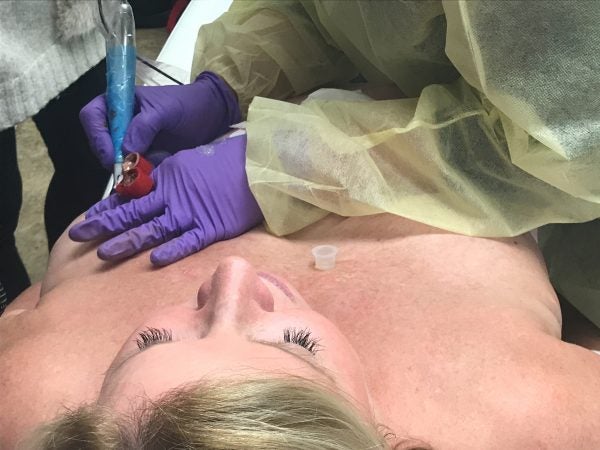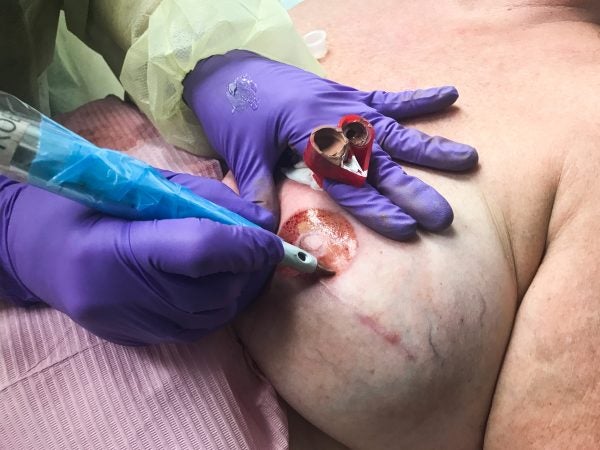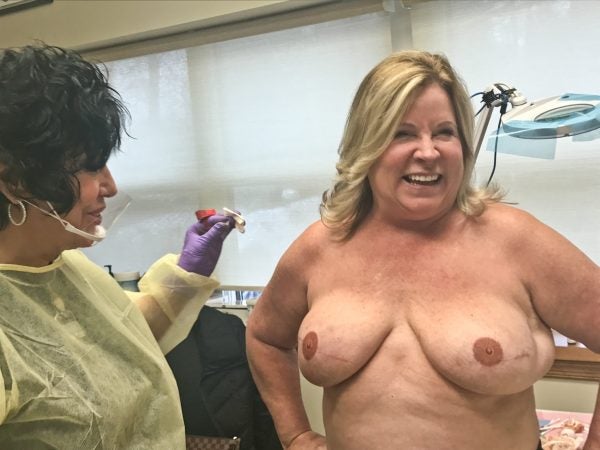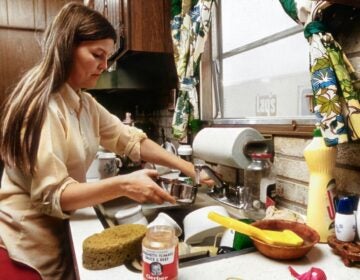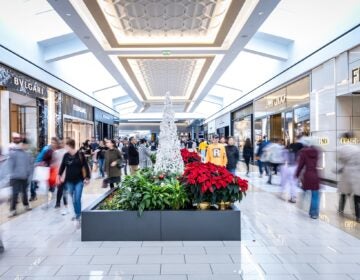After mastectomy, some women visit tattoo artists
The “illusion of protrusion” makes for a realistic nipple tattoo.
Listen 5:12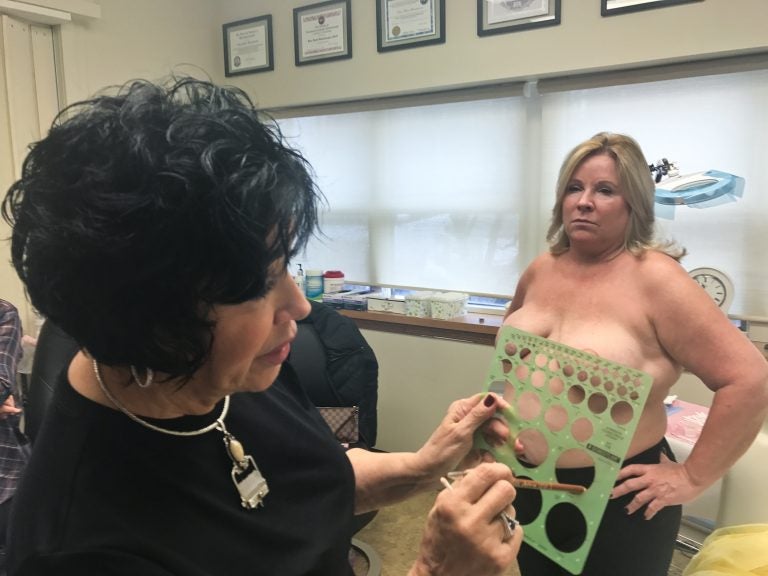
Rose Marie Beauchemin Verzella uses a template to pick the size of Maureen Matteis-Bilbee’s nipple and areola tattoos. (Alex Stern for WHYY)
“The first time I looked in the mirror and saw myself after my double mastectomy, it was kind of shocking,” Maureen Matteis-Bilbee says.
“I had major scars going straight across my breasts, and there were no areolas, no nipples. It felt like it wasn’t my body.”
Doctors found abnormal cells in Matteis-Bilbee’s breasts a few years ago. There’s a history of breast cancer in her family; her grandmother died of it when she was young. Matteis-Bilbee opted for surgery as the surest way to avoid cancer.
20 years ago, a breast reduction had repositioned her nipples and areolas. This time, the surgeon performing her mastectomy was not able to save them.
Afterwards, Matteis-Bilbee went through the process of reconstructing her breasts. With her new implants, it was hard for most people to tell that anything was different. She wasn’t entirely back to normal, though — which is why she decided to visit Rose Marie Beauchemin.
Beauchemin is the owner of the Beau Institute in Mount Laurel, New Jersey, a studio that offers permanent cosmetics. Sometimes called “the Brow Queen,” Beauchemin is known both for her tattooed, textured brows and for the hyper-realistic, 3D-looking nipples and areolas she creates for women who’ve undergone mastectomies.
Beauchemin sees Matteis-Bilbee’s nipple-less breasts as “a blank canvas.”
“Without a nipple, it’s almost like a face without an eyebrow,” Beauchemin says. “You know, it’s expressionless.”
Beauchemin is preparing to tattoo Matteis-Bilbee in a small room at the Institute that feels part salon, part doctor’s office. The room is crowded with women observing and offering support, including Matteis-Bilbee’s sister, Beauchemin’s assistant, and several students.
Matteis-Bilbee sits topless on an exam table covered in crinkly paper and cracks a joke — she had told her husband she might come home with daisies around her nipples. The women laugh.
First, Matteis-Bilbee and Beauchemin pick out colors. “I was like a medium pink,” Matteis-Bilbee remembers.
Beauchemin mixes several inks together, adding an extra drop of beige, then an extra drop of pink. She tests the color on Matteis-Bilbee’s breasts. “Yeah, I think that’s pretty,” she says. “I like!”
Beauchemin uses a pencil to outline where Matteis-Bilbee’s areolas and nipples will go. She sizes them using a template, but she positions them by eye. “I don’t like them too close to the middle because they look like headlights. A little bit more lateral is a more natural look,” she explains.
This gallery contains images of breasts and realistic nipple tattoos.
Every few moments, Beauchemin checks in with the room and with her client. Is the color too pink? Are the nipples too high? She adjusts as she goes until everybody is satisfied. Then, she fills up compartments in a heart-shaped ring with several shades of ink and turns on the cosmetic tattoo machine.
According to Beauchemin, realistic areola and nipple tattooing is all about creating “the illusion of protrusion.”
“Because we’re taking a flat surface and we’re trying to bring it to life,” she says. “We need to create dimension. And the way that you do that is with simultaneous contrast. We need light against dark.”
Beauchemin checks in with Matteis-Bilbee to make sure she isn’t feeling any pain. Many mastectomy patients lose sensation in their breasts, but there’s no consistent rule. Matteis-Bilbee feels the needle only in certain areas, rating her pain as a 4 on a scale of 1 to 10, so Beauchemin applies a topical anesthetic as she tattoos.
In order to represent texture, Beauchemin tattoos on montgomery glands, whitish bumps scattered across the areolas.
“The thing with the montgomery glands — don’t overthink them because they’re random, you know? Make them irregular. So I like a little set of triplets like that. And then we’ll do some twins here,” she says, dotting them on with white ink.
She also adds the appearance of vascularity to the areolas with some darker ink and a wiggle of her needle.
“It’s very rewarding, bringing back a woman to a state that she was familiar with, felt feminine with, felt confident with,” Beauchemin says. “She needs to feel whole again.”
Beauchemin performs her nipple and areola tattoos at no cost. She can offer a free service because her clients double as models in a nipple-tattooing course, where students pay to learn the craft by watching Beauchemin in action.
Once Beauchemin has made her final adjustments (tweaking the perimeter of one of Matteis-Bilbee’s areolas, adding a bit more texture to the other), she lines up the onlookers so that they block the thickly-framed mirror hanging on the wall.
“This is the big reveal!” she says.
Everybody steps back until Matteis-Bilbee is facing her new reflection. Her face is soft and flushed.
“Oh wow. Oh my God, they look awesome,” she says. “Thank you so much!”
“You’re so welcome! Oh my God!” Beauchemin says.
She asks for a selfie, once Matteis-Bilbee is all healed, and hands her a t-shirt as a parting gift. It reads, “Guess where my tattoo is?”
WHYY is your source for fact-based, in-depth journalism and information. As a nonprofit organization, we rely on financial support from readers like you. Please give today.



